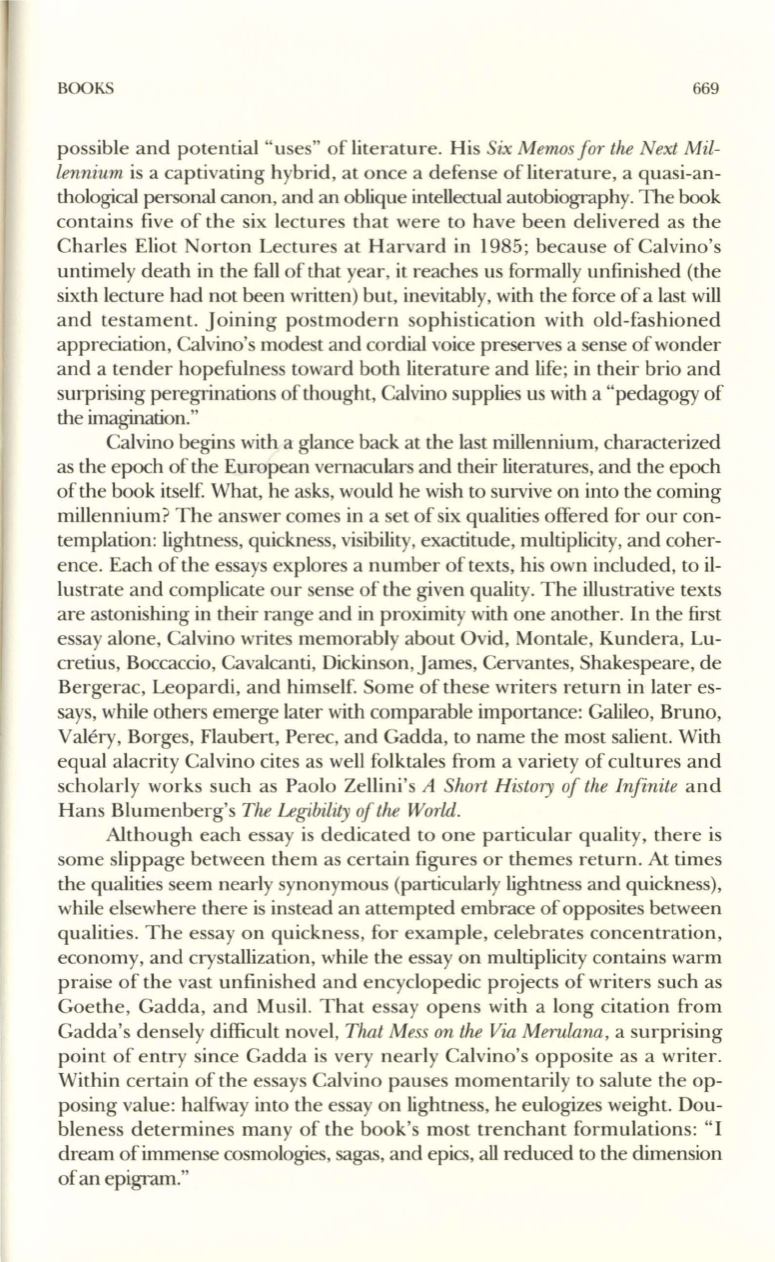
BOOKS
669
possible and potential "uses" of literature. His
Six Memos Jor the Next Mil–
lennium
is a captivating hybrid, at once a defense of literature, a quasi-an–
thological personal canon, and an oblique intellectual autobiography. The book
contains five of the six lectures that were to have been delivered as the
Charles Eliot Norton Lectures at Harvard in 1985; because of Calvino's
untimely death in the fall of that year, it reaches us formally unfinished (the
sixth lecture had not been written) but, inevitably, with the force of a last will
and testament. Joining postmodern sophistication with old-fashioned
appreciation, Calvino's modest and cordial voice preserves a sense of wonder
and a tender hopefulness toward both literature and life; in their brio and
surprising peregrinations of thought, Calvino supplies us with a "pedagogy of
the imagination."
Calvino begins with a glance back at the last millennium, characterized
as the epoch of the European vernaculars and their literatures, and the epoch
of the book itself. What, he asks, would he wish to survive on into the coming
millennium? The answer comes in a set of six qualities offered for our con–
templation: lightness, quickness, visibility, exactitude, multiplicity, and coher–
ence. Each of the essays explores a number of texts, his own included, to il–
lustrate and complicate our sense of the given quality. The illustrative texts
are astonishing in their range and in proximity with one another. In the first
essay alone, Calvi no writes memorably about Ovid, Montale, Kundera, Lu–
cretius, Boccaccio, Cavalcanti, Dickinson, James, Cervantes, Shakespeare, de
Bergerac, Leopardi, and himself. Some of these writers return in later es–
says, whjle others emerge later with comparable importance: GaWeo, Bruno,
Valery, Borges, Flaubert, Perec, and Gadda, to name the most salient. With
equal alacrity Calvino cites as well folktales from a variety of cultures and
scholarly works such as Paolo Zellini's
A Short History oj the InJinite
and
Hans Blumenberg's
The Legibility oj the World.
Although each essay is dedicated
to
one particular quality, there is
some slippage between them as certain figures or themes return. At times
the qualities seem nearly synonymous (particularly lightness and quickness),
while el ewhere there is instead an attempted embrace of opposites between
qualities. The essay on quickness, for example, celebrates concentration,
economy, and crystallization, while the essay on multiplicity contains warm
praise of the vast unfinished and encyclopedic projects of writers such as
Goethe, Gadda, and Musil. That essay opens with a long citation from
Gadda's densely difficult novel,
That Mess on the Via Merulana,
a surprising
point of entry since Gadda is very nearly Calvino's opposite as a writer.
Within certain of the essays Calvino pauses momentarily to salute the op–
posing value: halfway into the essay on lightness, he eulogizes weight. Dou–
bleness determines many of the book's most trenchant formulations: "I
dream of immense cosmologies, sagas, and epics,
all
reduced to the dimension
ofan epigram."


